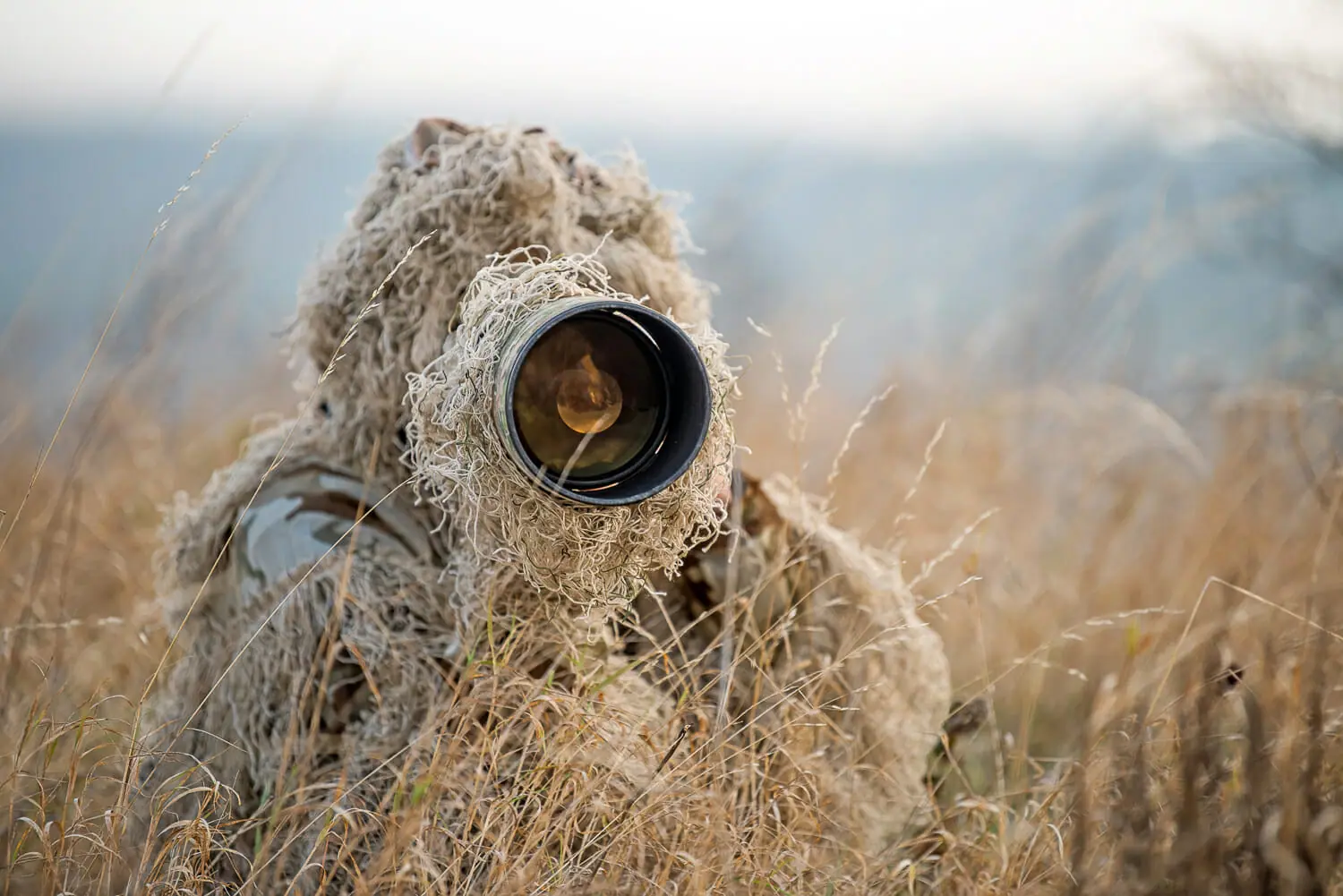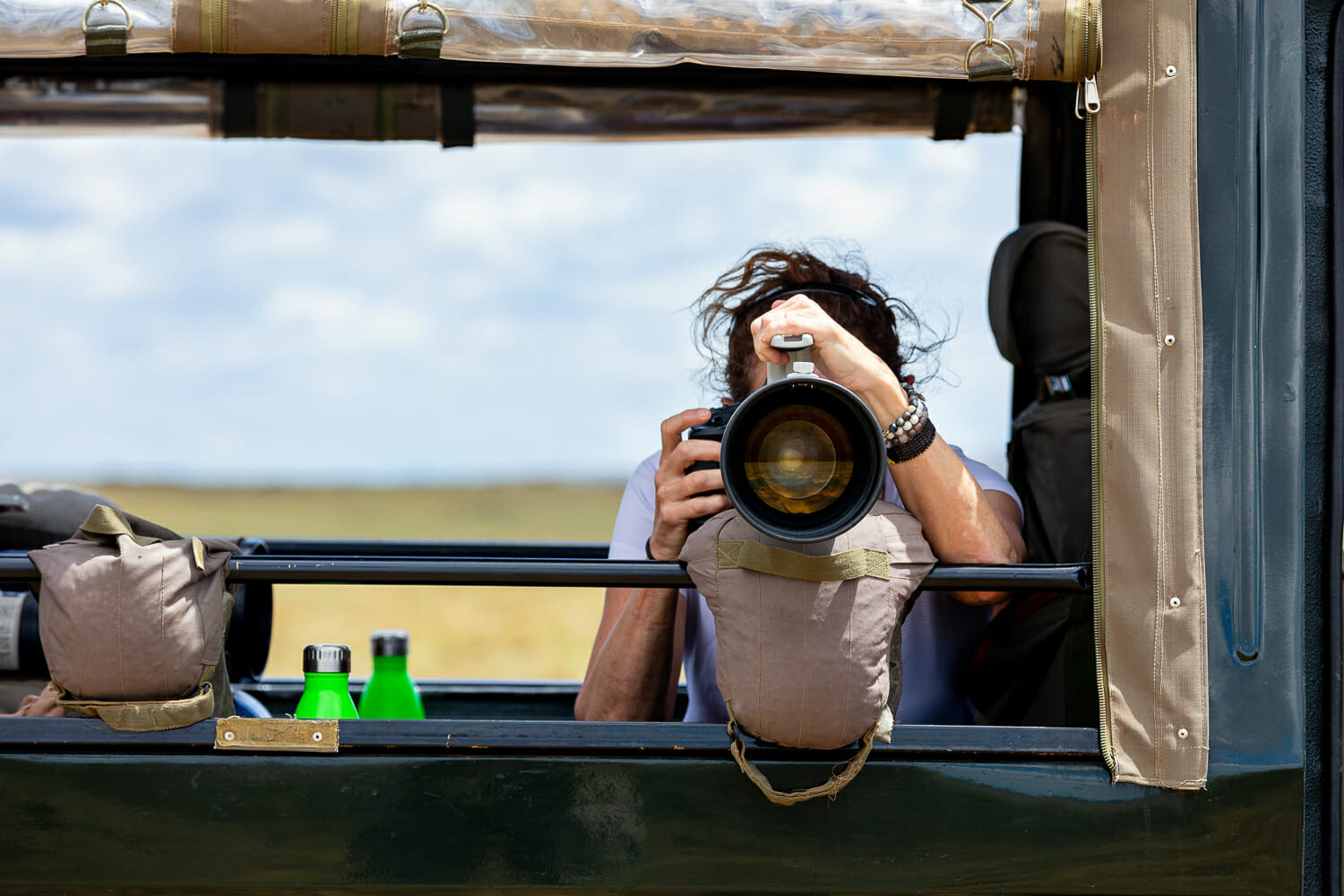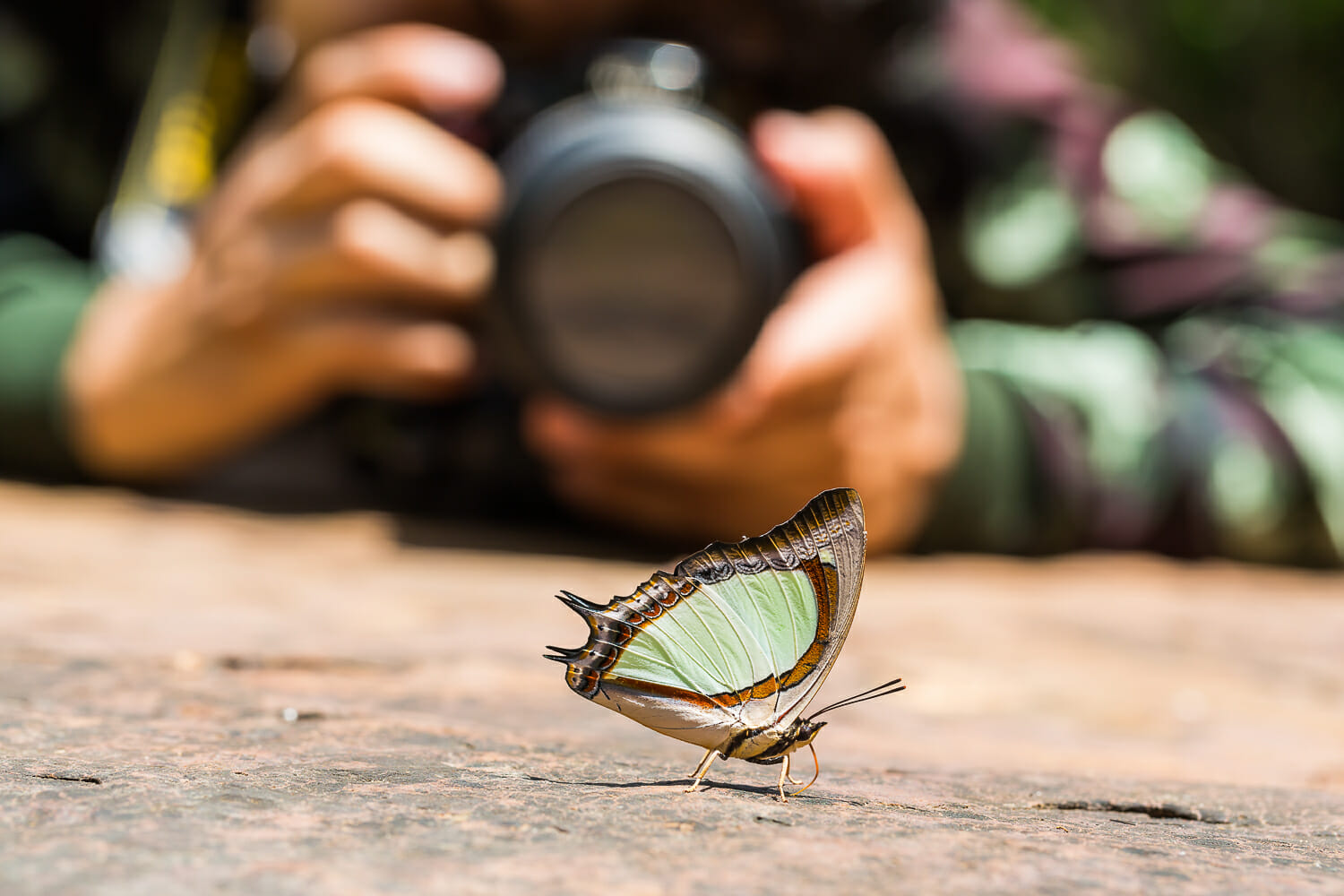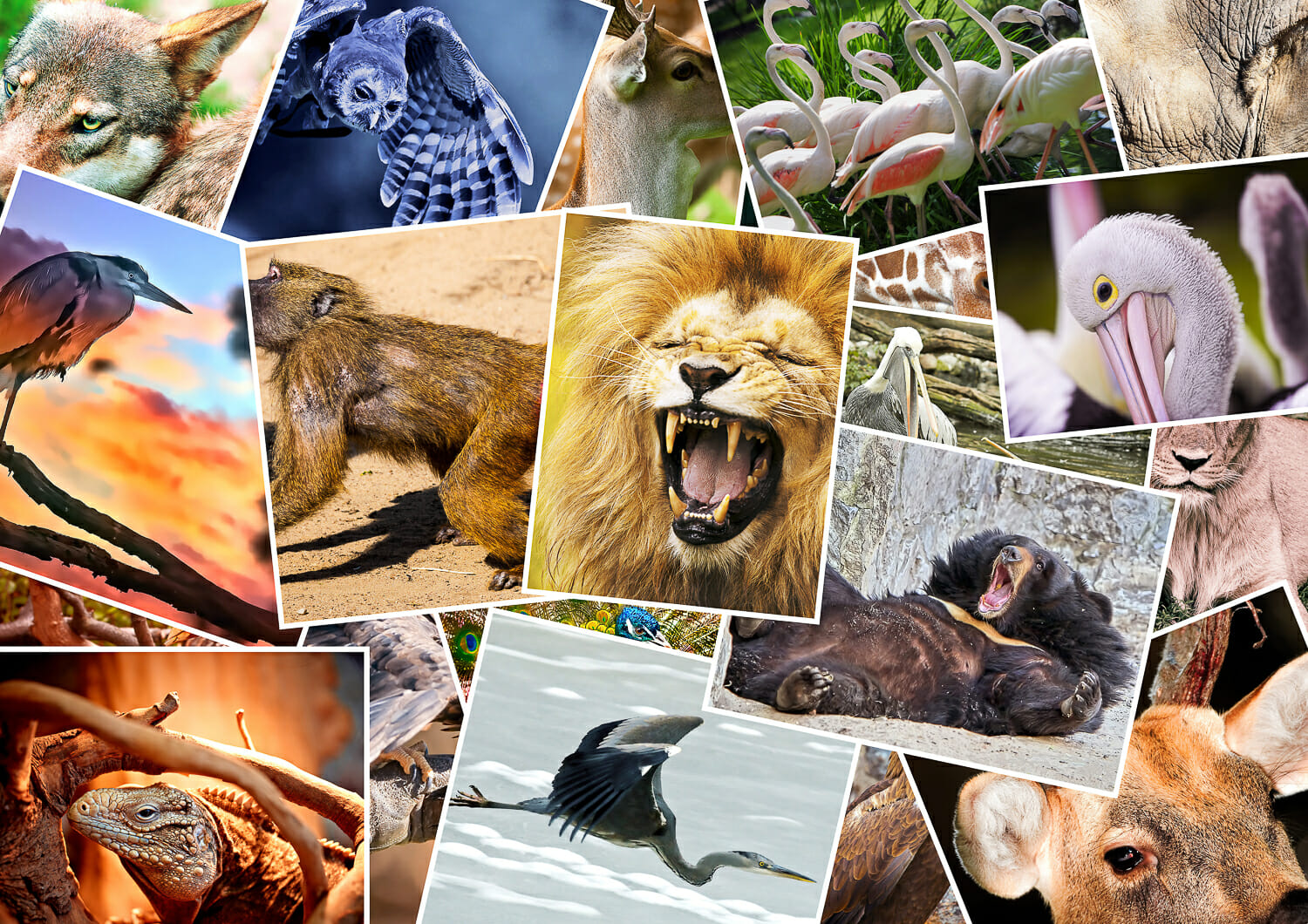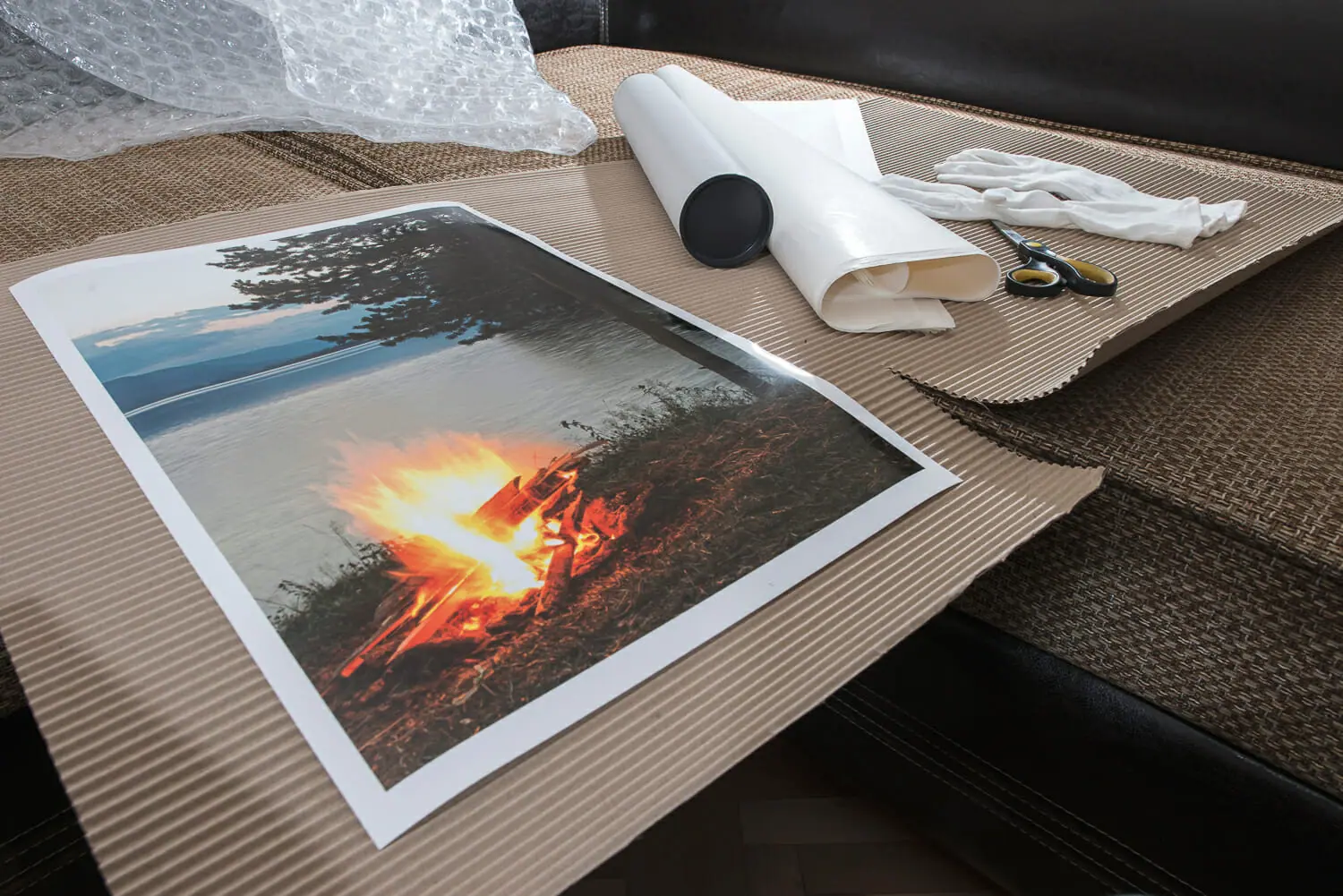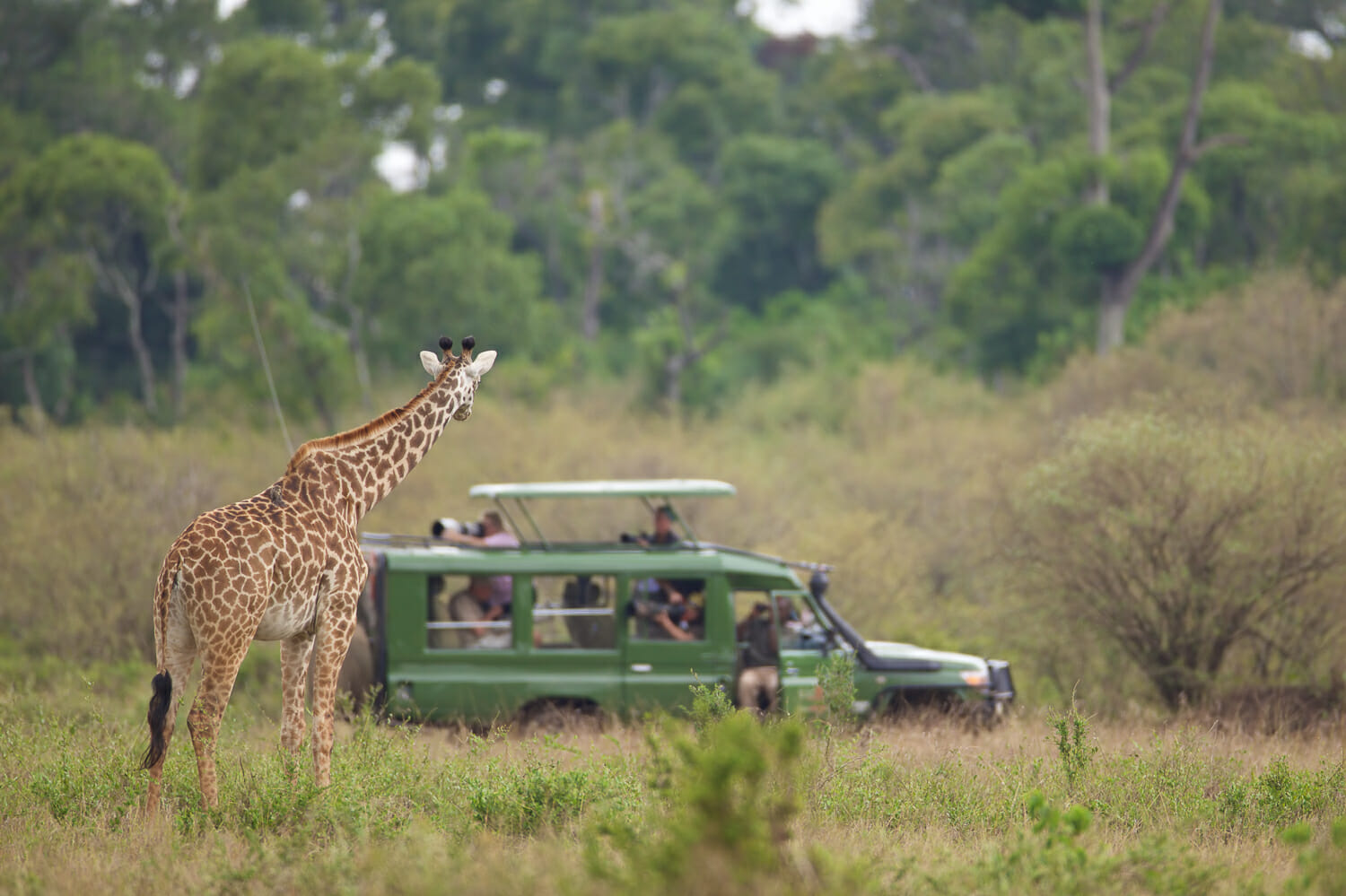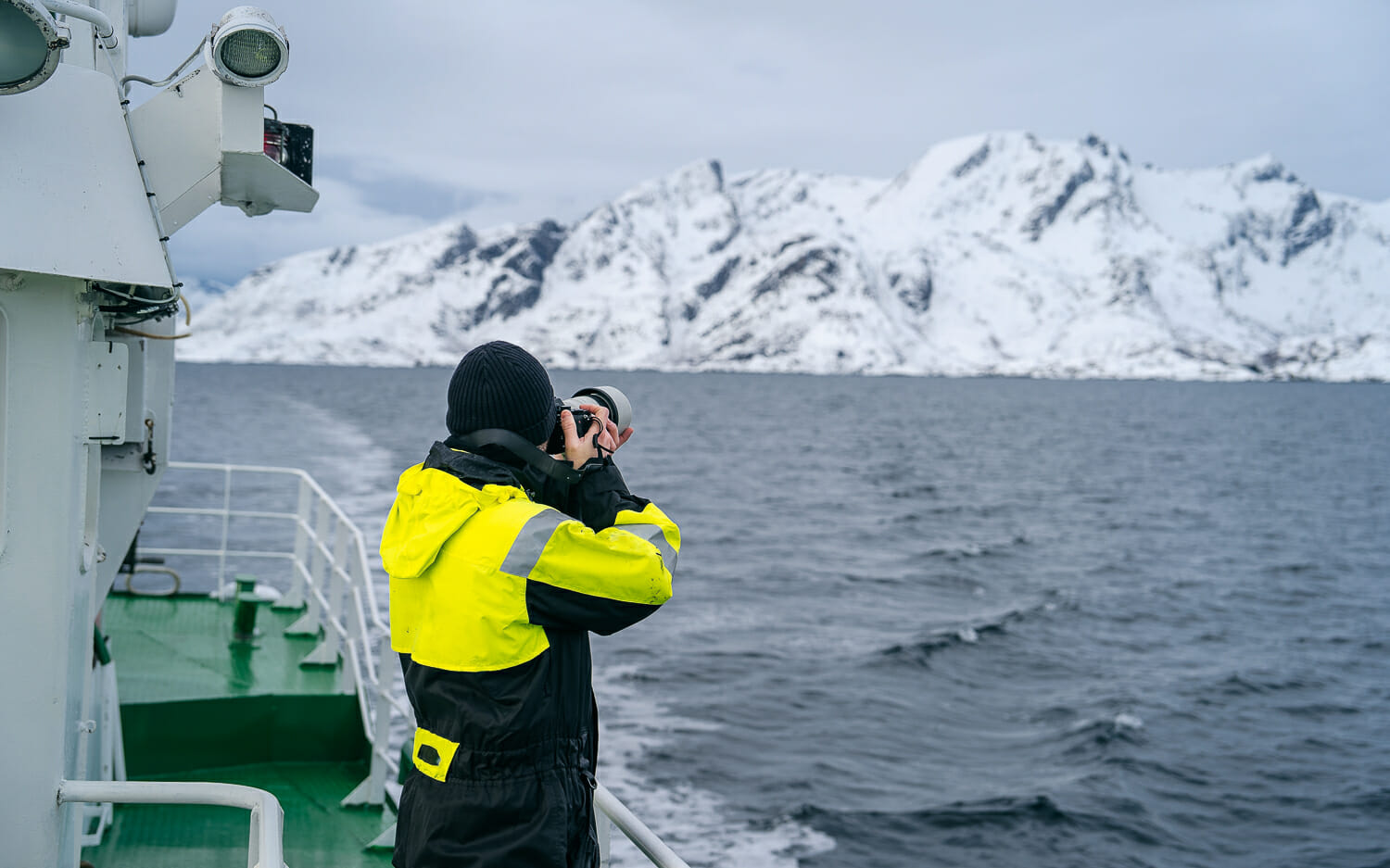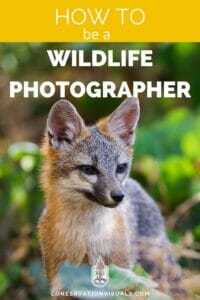Read Time: 11 minutes
Oh, that thrill of picking up a camera, heading outside, and photographing animals. It's addictive. The only place you want to be is off somewhere in nature, creating beautiful photos of the species you see.
It's not long after making those first frames that you start to think, “Hey, can I make a go of this as a career and spend all day outside making photos!!?”
Anyone with a passion for wildlife photography has wondered this at least once… or maybe it's a thought that keeps you up at night as you plan an exit strategy from your day job? If that's you and you're excited about becoming a wildlife photographer, this guide is your starting point.
Fact is, it's challenging to pursue wildlife photography as a career, especially since it requires technical and artistic skills and exposure to unpredictable natural settings.
Still, it can also be incredibly rewarding both from a professional and personal point of view.
Not only do you get to spend time studying animals' lives, but you also have the opportunity to capture breathtaking moments and share them with the world.
In this article, you have a step-by-step guide on how to become a wildlife photographer and earn an income from it.
Contents
What exactly is wildlife photography?
Simply put: You're aiming your camera at critters and documenting their lives, with the goal of never disturbing them or changing their behavior so that the photos you do make reflect wild reality.
While the definition is simple, the reality is a bit more complicated.
Most people imagine it to be a glorious time outside, immersed in nature. But wildlife photography often takes place in remote areas with unpredictable weather conditions. The focus species is often difficult to find or photograph. And once you do find your subject, you need to have a mastery of your camera plus a creative eye to make wildlife images that wow an audience.
Depending on the type of wildlife you focus on, to the kind of work you create, you have specific skills you'll need to master to become a professional wildlife photographer.
Now that we've covered what it IS, let's talk about what you'll DO as a wildlife photographer.
Photo: Jane Rix/Shutterstock
Wildlife photographers can use their images to both show the beauty of nature and help raise awareness and advocacy for the conservation of habitats and species.
What do wildlife photographers do?
Wildlife photography can also be considered a type of conservation work. The photos you create can be used specifically to bring awareness, attention, understanding, and action to improve habitats or protect species.
A wildlife photographer may focus on the following:
- shooting assignments for publications
- selling stories to outlets
- creating images to license
- selling prints
- partnering with nature organizations to document particular species or conservation efforts
- and much more
The job of a typical wildlife photographer can be extremely difficult and comes with substantial investments in professional camera equipment (especially at the beginning of their journey), time availability, and personal commitment.
If you're really into wildlife photography, you'll realize that the time and investment were well worth it once you see your first shot.
As a bonus, once you master your skills and learn how to promote yourself on the right platforms, you can start making money from your hard work.
Photo: Matee Nuserm/Shutterstock
You don't have to be a full-time pro to make both an impact and an income with your images. You can make significant progress by focusing on your photography on a part-time basis.
Important: You don't have to be a full-time wildlife photographer
Many professional wildlife photographers earn enough from their pictures to make a full-time living, especially if they've been in the photography industry for a while.
However, if studying wildlife and taking great photos are more of a hobby to you, there's a way to turn this passion into a side gig and earn extra income. And, because it is increasingly difficult to make a full-time living in wildlife photography, it may be ideal for you to supplement your day job with your photography passion.
Either way, it all boils down to time management.
If you're not ready to fully commit to photographing animals full-time, you can practice taking photos after work or during weekends while maintaining a job or pursuing other passions.
Professional wildlife photographers often have part-time jobs that allow them to finance their photography work. However, they use their free time to practice and improve their skills in wildlife photography.
So, even though you may be chomping at the bit to spend 100% of your time outside with animals, consider using this as a side gig that provides a creative outlet while you grow your skills to professional levels.
Photo: Setta Sornnoi/Shutterstock
Becoming a highly skilled wildlife photographer requires practice, practice, practice. And of course a willingness to immerse yourself in nature… sometimes literally!
7 steps to become a professional wildlife photographer
Whether you dive in full force right now or make a plan of action over the next few years, here are the steps you'll need to take to become a pro:
1. Invest in quality camera equipment
I absolutely support starting with the equipment you have right now. Use whatever camera you have to improve your composition skills and stealthy wildlife tracking skills.
But when you're ready to make the leap to pro, you'll need to invest in quality camera equipment.
There are no two ways around it: quality gear helps you make quality pictures. You'll need pro-level camera bodies, high-end lenses, sturdy tripods, and other accessories, depending on what you're shooting, so your pictures are competitive.
That said, learn the basics of photography before investing in expensive gear.
When you're ready, we have thorough guides to the best camera bodies and best lens choices for wildlife photography that'll help you make the just-right decision for you.
2. Study animal behavior and learn naturalist skills
Understanding animal behavior is vital to getting great shots as a wildlife photographer. Learn everything you can about your target species and their habits so that you can better predict their movements and capture them in their natural environment with ease.
Take the time to learn naturalist skills, which help you to spot signs, trail wildlife, and perhaps most importantly, ask insightful questions that guide you to capturing shots of unique behaviors or situations.
To help you out, here's a free guide on 5 naturalist skills that will transform your photography. It includes exercises, resources, and templates I use in my naturalist practice that you can print and start using immediately.
3. Practice photographing local wildlife
Once you have the right equipment, it's time to practice crafting stellar photos of animals. Start by visiting local parks or preserves where there is plenty of wildlife to photograph and observe their behavior. This'll give you an understanding of animal movements and help you anticipate shots more effectively.
Dig into essential techniques like photographing birds in flight or animals on the move, watching for interesting behaviors to document, using natural light to create dynamic images, and thinking creatively about composition. You'll need to go beyond the static “bird on a stick” shots that everyone has and instead purposefully make images that surprise and amaze viewers.
4. Develop your photo editing skills
Developing your editing skills will help you get the most out of your photos and make them look even better than they already do!
Raw images from your camera will look good enough but won't have that professional touch that comes from processing photos properly afterward using software like Photoshop or Lightroom. Invest in editing software and practice how to use it for subtle yet powerful adjustments.
Photo editing is about more than just post-processing your images. It's also about image selection. Learn how to look critically at your photographs and choose only the best. Notice why some photos don't work as well as others, and learn from them.
A great wildlife photographer doesn't just worry that they have sharp photos; they're also ensuring their photographs are unique and surprising, too.
Photo: Dariush M/Shutterstock
A strong portfolio isn't necessarily about the breadth of subjects you've photographed. More important is that the images are unique, compositionally strong, and express your style.
5. Build your portfolio
Once you have solid foundations in processing your photos and choosing the best shots to show, it's time to build your portfolio. This is where you really start to stretch yourself as a photographer.
Work on crafting photos of different animals, locations, weather conditions, or other topics. As you build your portfolio, you'll be able to show off the diversity of skills and knowledge you have, plus you'll be building up a healthy archive of images to license down the road.
Note: When building your portfolio, notice where your unique style shines and lean into it while expanding the breadth of what's covered in your body of work. That's how you'll build a portfolio that is uniquely yours.
6 Network, network, network!
Networking is an essential part of any successful career, and this is especially true for wildlife photography. To find the right opportunities and build a successful business, you want to establish relationships with other wildlife photographers, editors, publications, agencies, and potential clients.
Networking will open up surprising doors – including leads for photo story ideas, publishing opportunities you'd never have known about, or people who can help you get access to off-limit locations. You just never know!
It's also a great way to learn from more experienced professionals in the field who'll provide valuable advice on how to get started in wildlife photography. By leveraging your connections, you'll expand your reach and increase your chances of success as a professional wildlife photographer.
🔥 Pro Tip: A surprising networking opportunity comes in winning photography contests. Not only can winning help you bring attention to wildlife and conservation issues you care about, but it also opens the door to conversations with editors, publications, and potential collaborators. Check out our list of top nature and wildlife photography contests to consider.
7. Start a local photography project
Starting a local project can be an excellent way to build your skills and become known for something specific in the wildlife photography industry.
Not only does it provide you with valuable experience, but it also allows you to showcase your work and gain recognition from potential clients.
A local project could involve taking photos of animals in a particular area or documenting changes over time as different species come and go. A local photo project is an opportunity to gain deep knowledge of a specific topic and demonstrate your commitment to wildlife photography while also providing evidence that you can capture stunning images that show off your creative abilities. Moreover, having a portfolio of beautiful shots taken during these projects makes it easier for prospects to trust that you can produce quality work.
Starting a local project is an invaluable step towards becoming successful as a professional wildlife photographer!
Now, let's explore 11 revenue streams that you can take advantage of as a wildlife photographer to make more money.
Photo: Deyan Georgiev/Shutterstock
There are many ways to make an income as a professional wildlife photographer. From selling prints to leading tours to photographing nature conservation stories, you can find revenue streams that best fit your personality and specific passions.
11 revenue streams to try out as a wildlife photographer
Client Work
Photographers specializing in wildlife photography can get paid for taking pictures for clients, such as companies or organizations focused on nature or wildlife issues. This may include photography for awareness campaigns, marketing efforts, or other needs.
Fees for these services are typically negotiated on a per-project basis, so make sure to include as many expenses as you can in the price of your packages.
Some examples of expenses as a wildlife photographer include:
- Travel expenses
- Renting equipment
- Purchasing additional accessories like hard drives or memory cards
- Permits and access fees
- Hiring an assistant for the shoots
Finding clients takes time, but once you establish relationships and build a reputation for providing great work on time, you'll start to grow through referrals and build momentum based on word-of-mouth.
Assignment Work
Wildlife photographers can also receive income from assignment work, where they're hired to take photos for a specific purpose. This might be documenting a photo story for a publication, covering events for news outlets, or even long-term assignments that cover an event or issue that unfolds over time.
When it comes to assignment work, you might be paid a flat rate for the project, or you might negotiate a day rate and be paid for the number of days it would take you to complete the project.
Photo: Mark Bridger/Shutterstock
Leading wildlife photography tours and workshops is a great way to fund your own field time. You get to show other people amazing locations and species while also building your own portfolio.
Workshops, Tours & Teaching
Photographers can also make money by organizing workshops and tours. You can provide in-depth instruction on how to photograph different species of animals or places, or simply guide participants to the best spots to get beautiful shots.
The fees charged for workshops and tours also cover your travel expenses, so this is a great way to earn side income, spend some more time in nature, and boost your exposure.
By planning time in the location before and after the tour for your own photography, you could come home with photo stories to sell or images to license.
Licensing Images & Stock Agency
As a wildlife photographer, one of the most common ways to generate revenue is by licensing images for use in publications or even on commercial products.
Most wildlife photographers create photos of nature and wildlife which they can then license to media outlets and stock agencies. The stock image industry isn't what it used to be, but you can still earn a good revenue stream from it. Check out reputable agencies that focus on wildlife photography, such as Minden, Tandem, and Nature Picture Library.
Of course, you don't have to take part in stock websites. You can also license your images yourself and use a license pricing tool like Fotoquote to determine a competitive rate.
Pitching Stories
A great way for wildlife photographers to generate revenue is by pitching photo stories to magazines and other publications.
News outlets are always looking for the next big story, so if you have stunning wildlife photos or manage to capture pictures of endangered or rare species, you might be one step away from a lucrative deal.
You can create a photo story and then shop it around to publications to see who accepts it, or you can pitch an idea and hope to get an assignment to go photograph your story idea. Either way, photo stories are an exciting way to get your work published while also building up your archive of licensable images.
Further Reading: How to Create a Photo Essay in 9 Steps
Grants
Wildlife photographers can fund their work by applying for grants from organizations focusing on wildlife conservation (such as Terra Viva or NANPA Foundation) or even governmental programs.
Depending on the grant's terms, the funds can cover the cost of travel, equipment, or even paying yourself a day rate.
Photo: Screenshot from Patreon.com
Memberships
Membership platforms can be a great way to generate income from your photography skills. This allows photographers to build a subscription service where people can pay a monthly fee to gain access to exclusive content, tutorials, and tips.
Here is a list of platforms that you can use as a wildlife photographer to host your membership-based services:
- Patreon
- Mighty Networks
- Podia
- Memberpress (this WordPress plugin allows you to monetize your site with subscribers)
More and more professional photographers are using memberships to help fund their work in the field, while also teaching and mentoring upcoming photographers. It takes a lot of work to run a membership successfully, but it's a wonderful win-win option.
Prints & Calendars & Books
Printables are a popular way for wildlife photographers to make money. Selling prints and other photographic items that users can easily print on dedicated websites (such as Etsy) is one of the most efficient ways for a wildlife photographer to earn passive income.
Depending on the uniqueness of the wildlife photos, a professional photographer can charge a premium for their work. A good wildlife photographer can create quality pictures that stand out from the rest, and by turning them into printable items, they can generate passive revenue.
Gallery Sales & Exhibit Sales
Photographers can showcase their work in galleries and museums, or can enter competitions to get their work in front of a wider audience. One aspect to note is that you don't have to own a gallery or personally know the owner of one. You can offer to collaborate with your local gallery or join an auction/ exhibit sale.
You can also set up a booth at events and sell prints to the public. This is an expensive option because of the overhead involved, but once you've set up your foundations, it can be a great way to travel and sell prints.
Photo: kasakphoto/Shutterstock
While it's true that some professional wildlife photographers travel around the world for their work, it's possible to focus your efforts closer to home. This lowers your overhead and carbon footprint, and gives you more opportunity to use your images for local conservation impact.
How much does a professional wildlife photographer make per year?
A career in wildlife photography is different from many other fields. For instance, having a formal education in photography can be helpful but isn't mandatory to be successful and get hired. Also, you might work as a staff photographer for a company, but more often than not, you're freelancing.
Your ultimate success – and pay rate – depends on your experience level, skill, niche, network, willingness to learn new technical and business skills, and much more.
But… how much money do you make?
Well, there's really no such thing as a wildlife photographer salary. Because revenue depends on a vast range of factors — including if you're freelance or work for a production company; if you're an assignment photographer or leading tours; if you have multiple revenue streams or just one, and so much more — how much a wildlife photographer makes is hard to say with precision.
Most labor statistics websites will put the salary range between $30,000-$45,000, depending on location, with a national average of about $43,000.
What you actually make depends on many factors, but you can use this as a rough estimate of what you might make as a pro.
Is it hard to become a wildlife photographer?
Yes. I won't beat around the bush about that.
It takes a lot of work to start a career in wildlife photography for many reasons. From the demand on your time and physical capabilities to the sheer level of competition in the field, to the overhead expenses of gear, insurance, and travel, it takes true determination to become a professional wildlife photographer.
But it is possible. And it is an emotionally and creatively rewarding job.
If you're serious about becoming a wildlife photographer, I strongly recommend learning more about conservation photography.
Conservation photography combines your love for wildlife with the ability to make a genuine, lasting positive impact for the species and places you photograph. Learn more in our complete Guide to Conservation Photography.

